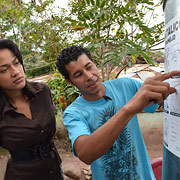 The POSTCOSECHA business model is based on a public-private development partnership.
The POSTCOSECHA business model is based on a public-private development partnership.
In Central America, public funds provided by the Governments of Honduras, Guatemala, Nicaragua and El Salvador, with support from the Swiss Agency for Development and Cooperation (SDC), were used to finance the strategy support measures. Private funds were used by tinsmiths to start or upgrade their businesses, and by farmers to purchase the silos.
During the first years of the program, public funds were mainly used to cover costs for technology development and technology testing. Once the technology was fully developed and tested, public funds were mainly used to cover strategy management costs, plus extension and training costs. In some cases, public funds were used to start up or develop private enterprises (tinsmiths, credit institutions, suppliers of raw materials).
Production and purchase of silos, supply of raw materials, and provision of credit for production and purchase was all done by private institutions. Program management intervened in the beginning to organize and coordinate private initiatives in this domain.
|
Business model: main critical factors Private enterprise development/organization/coordination without distortion of market mechanisms Avoidance of hidden subsidy mechanisms that are unsustainable without aid |
back to POSTCOSECHA
